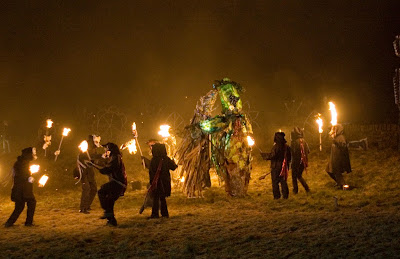HIST & MYTH: The Hag’s Chair – An Cailleach Bhéara
Written by Ben Kesp
In a time when magic was feared, a power practiced by witches and sorcerers, one witch attempted a feat which resulted in her death but has left us with a remarkable landscape. In her attempt to rule over all of Ireland, she began the challenge of dropping an apron of stones on each of the Loughcrew Hills in Co. Meath, Ireland. But on the third hill she missed and fell to her death resulting in an assortment of 5,000 year old passage tombs which can be seen scattered across the hills. She was known as An Cailleach Bhéara or the Hag of Beare.
The Hag of Beare is an interesting character and is embedded in folklore going back to the beginning of time. Her origins may spring from the Irish Goddess Buí (Cow – Old Irish). She was a Sovereign Goddess, an Earth Mother, a Supernatural Creator and who presides over the Irish landscape. She has also been noted for forming islands, transforming lakes into mountains and placing boulders in rivers. An Cailleach Bhéara was known to have a long life span, passing through seven periods of youth. Not only is she associated with the Hags Chair at Loughcrew Hills but also with the Beara Peninsula in Co. Cork where a natural rock is said to bear her facial image. Her burial site is stated to be at Labbacallee Wedge Tomb in Cork.
 |
| Loughcrew Hills, Ireland |
However all of these great sagas aside the studies carried out on An Cailleach Bhéara have seen a connection between ancient folklore and earth’s geological evolution. She is without doubt a complex figure, often depicting different cultural meanings like the dark side of Mother Earth, a deity at odds with mankind who has left her mark on the landscape and has been connected to many other Irish deities. Comparisons have been drawn between her and the Irish Goddess Morrígan (War, Death & Rebirth) - perhaps they all encompass each other, shape shifting as the yearly seasons move over the landscape.
Her demise from a goddess of destruction to an old woman or hag came about following the first written records of her in the 9th century by the Christian scribes. “The Lament of the Old Woman of Beare” is a text from the 9th century which has been called a “remarkable” poem in medieval Ireland. The poem tells of An Cailleach Bhéara as once a formidable being, able to renew her energy from the forces of nature but is now a pitiful degraded old woman in a new patriarchal society.
Myths and tales are wonderful, giving us stories of origin, of how things might have come into being. The site at Loughcrew Hills today contains a vast Neolithic necropolis and passage tomb cemetery, one of the most concentrated in Ireland. First discovered by Conwell, however in the 1860s, a Dutch artist by the name of G.V Du Noyer created very accurate paintings of the magnificent art work and made remarkable copies of stone engravings. Much of the art work has since faded on the original stones due to exposure to the elements and weathering. These drawings provide an excellent record into the artwork decorating the tombs and stones.
One of the most impressive stones on site and one you cannot miss is the Hag’s Chair. This is a massive block of stone with arm rests, measuring 3 metres by 1.8 metres high with a weight estimated at 10 ton. On the seat of the chair is a carving of a cross. Many uses are claimed for the seat with one stating it was once a “Mass Rock” during penal times but earlier tales state it belonged to the Hag of Beare where she sat looking over her domain. Today it is claimed that when women sit on the chair they will feel an energy rising upwards through their body from the inscribed cross. A wish will also be granted to whoever sits on the throne.
 |
| The Hag's Chair - Loughcrew Hills. |
Conwell believed that the Hag’s Chair belonged to the “law giver king”, Ollamh Fodhla and the great tomb resting behind the chair belongs to him. The smaller tombs surrounding, Conwell states would belong to Fodhla’s sons and grandsons. He had referenced the chair as Ollamh Fodhla’s Chair.
With so many myths and legends it is difficult to decipher or truly know the origin or use for this massive throne shaped chair resting outside a large tomb. However what is clear is the strong association the Hag of Beare or An Cailleach Bhéara has with the land of Ireland. Does she still preside over its green and lush landscape, embedded at its very core?
Check out this 8 minute clip from the Irish Film Board
Images: Knowth.com and the Irishfilmboard.ie



Comments
Post a Comment